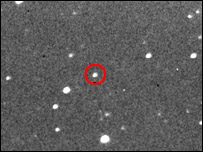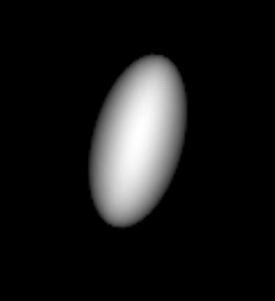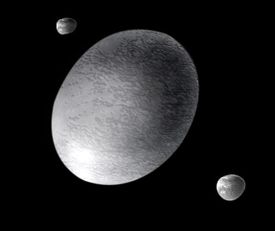Haumea

Discovery photo of Haumea.

Periodic variations in the brightest of Haumea are thought to be due to its exceptionally elongated shape.

Artist's impression of Haumea and its two moons. (Separation distances not to scale.)
Haumea is a large and unusual Kuiper belt object (KBO) of the type known as a plutoid (a dwarf planet lying beyond the orbit of Neptune). Previously known as 2003 EL61, it has two moons, spins very fast, and appears to be cigar-shaped. It is estimated to be about as wide as Pluto along its longest dimension and about half that along its shortest.
Haumea was discovered by a team from the California Institute of Technology consisting of Michael E. Brown, Chad Trujillo, and David Rabinowitz who had been observing the object for half a year with the 1.3-meter SMARTS Telescope. The discovery was made on 28 December 2004 and announced in 2005. In September 2008, Haumea was named, by the International Astronomical Union, after the goddess of childbirth and fertility in Hawaiian mythology.
Fast spin
In September 2005, researchers announced that Haumea was the fastest spinning large object known in the Solar System, rotating once every 3.9 hours. This means that instead of being roughly spherical, the object is stretched out into the shape of a squashed rugby ball. Knowing its shape, astronomers have deduced a density for Haumea of more than 2.5 times that of water and a reflectivity similar to that of fresh snow. A spiraling-in effect of the object and its moons might have been be the cause of the high rotation rate. Alternatively the fast spin might be the result of a major impact in which the moons were created.
The moons of Haumea
Two satellites have been found in orbit around Haumea. Both were discovered in 2005 and are of substantial size.
S/2005 (2003 EL61) 1 was the first of 2003 EL61's moons to be found. It was nicknamed "Rudolph" by the Caltech team which discovered it. It orbits Haumea once every 49 days at a distance of about 49,500 kilometers, with an eccentricity of 0.050 and an inclination of 235°. Its measured brightness suggests a diameter of about 350 kilometers, assuming it has a similar brightness to the primary. This would make it larger than all but four of the asteroids (1 Ceres, 2 Pallas, 4 Vesta, and 10 Hygiea) in the main asteroid belt.
S/2005 (2003 EL61) 2 is the smaller and inner moon of Haumea at a distance of about 39,000 kilometers from the primary. The orbital period is 34 days and the inclination 39±6° from the larger moon. Its diameter has been estimated at about 170 kilometers.
| diameter | ~1960 × 1520 × 1000 km |
| density | 2.6-3.3 g/cm3 |
| albedo | 0.7±0.1 |
| absolute magnitude | 0.1 |
| eccentricity | 0.189 |
| semi-major axis | 43.34 AU |
| perihelion | 35.16 AU |
| aphelion | 51.53 AU |
| orbital period | 285.4 years |
| inclination | 28.19° |


